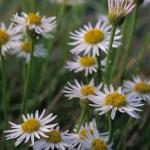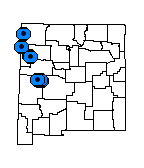Erigeron rhizomatus (Zuni Fleabane)
NONE
| USFWS | State of NM | USFS | BLM | Navajo Nation | State Rank | Global Rank | R-E-D Code | NMRPTC Status | Strategy Status |
|---|---|---|---|---|---|---|---|---|---|
| LT | E | GP 2 | S1 | G2 | 2-2-3 | R | SS |
| Overall Conservation Status | Documented Threats | Actions Needed |
|---|---|---|
| WEAKLY CONSERVED | Climate change/drought |
trend monitoring, habitat protection for known populations, Climate change and associated ecological impacts |
Herbaceous perennial with creeping rhizomes; stems 2.5-4.5 dm tall, sparsely branching from near the base, growing in clumps to about 3 dm in diameter; leaves alternate, oblong, about 1.0 cm long, glabrous except for occasional ciliate hairs on the margins; flower heads solitary terminating the branches, 13-16 mm wide, involucral bracts in several series; ray flowers 25-45, white or tinged with blue-violet, 6-7 mm long and 1.3-1.5 mm wide; disk flowers yellow; achenes 5-6 nerved, nearly glabrous, pappus 25-35 fragile bristles with a few short outer setae. Flowers May and June.
This is a very distinct species of Erigeron. The nearly glabrous achenes with 5-6 nerves, the showy flowers which appear growing in a large, cespitose clump despite the plant growing rhizomatously, and the sparse hairs on the stems and small leaves provide easy recognition.
New Mexico, Catron, McKinley, and San Juan counties; Arizona, Apache County.
Nearly barren detrital clay hillsides with soils derived from shales of the Chinle or Baca formations (often seleniferous). In the Datil/Sawtooth mountains Erigeron rhizomatus occurs mostly on or adjacent to the poorly defined transition zone between the Baca Formation below and the Spears Group above. The species is most often found on north or east-facing moderate to steep slopes in open pinyon-juniper woodlands and ponderosa pine forests at 2,200-2,400 m (7,300-8,300 ft), but can be found on all exposures.
This plant is know from 3 locations in the Zuni Mountains near Fort Wingate, 28 locations (probably more) in the Sawtooth and northwest Datil mountains, and at least 3 locations in the Chuska Mountains on the Navajo Nation.
The distribution of Erigeron rhizomatus is associated with the distribution of uranium deposits in west-central New Mexico. Many of the sites for this plant occur at historical or current mining claims. A 2014 status survey found the Datil/Sawtooth and Zuni Mountain populations in decline, likely in response to prolonged drought conditions.
Christie, K. 2004. Erigeron rhizomatus. Survey and status report. Unpublished report prepared for the Navajo Natural Heritage Program, Window Rock, AZ.
Christie, K. and W. McBride. 2020. Long-term Monitoring of Erigeron rhizomatus and Targeted Surveys for Undocumented Populations on the Navajo Nation. Unpublished report prepared for Arizona Dept. of Agriculture Endangered Species Act Section 6 Grant Program, Grant No. Segment 24-2019- 2021-5
Cronquist, A. 1947. A revision of the North American species of Erigeron north of Mexico. Brittonia 6:121-300.
*New Mexico Native Plants Protection Advisory Committee. 1984. A handbook of rare and endemic plants of New Mexico. University of New Mexico Press, Albuquerque.
*U.S. Fish and Wildlife Service. 1988. Zuni fleabane (Erigeron rhizomatus) recovery plan. U.S. Fish and Wildlife Service, New Mexico Ecological Services Field Office, Albuquerque, New Mexico.
Roth, D., and R. Sivinski. 2014. Status report for Zuni fleabane on the Cibola National Forest, New Mexico. Unpublished report prepared by the NM Energy, Minerals, and Natural Resources Department, Forestry Division, for the U.S. Forest Service, Cibola National Forest, Albuquerque, NM.
Roth, D. 2019. Status report New Mexico for Zuni fleabane (Erigeron rhizomatus). Unpublished report prepared by the NM Energy, Minerals, and Natural Resources Department, Forestry Division, for the USFWS, Region2.
For distribution maps and more information, visit Natural Heritage New Mexico










